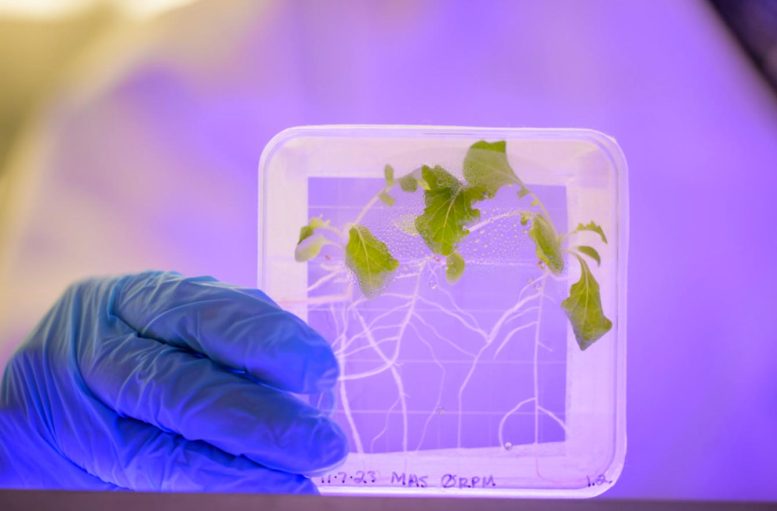 A study conducted by researchers at the University of Delaware has found that plants grown in space are more susceptible to infections from Salmonella compared to those grown under normal gravity conditions. Credit: Evan Krape/ University of DelawareLettuce and other leafy green vegetables are an essential part of the diet, even for astronauts on a mission. It has been more than three years since NASA introduced space-grown lettuce as a part of the menu for astronauts aboard the International Space Station. Alongside their regular space diet, astronauts are able to consume a salad made from plants grown in control chambers aboard the ISS, which provide the ideal conditions required for plant growth, including temperature, water, and light.The Challenge of Pathogens in SpaceHowever, there is a concern regarding the presence of pathogenic bacteria and fungi aboard the International Space Station. Many of these microorganisms are aggressive and can easily infect the tissue of lettuce and other plants. Consumption of lettuce contaminated with E. coli or Salmonella can lead to illness. Given the significant investment in space exploration, researchers are worried that a foodborne illness outbreak on the ISS could jeopardize a mission.A recent study by the University of Delaware, published in Scientific Reports and npj Microgravity, involved growing lettuce under conditions that mimic the weightless environment of the International Space Station. Plants are highly sensitive to gravity and utilize their roots to detect it. The study found that plants exposed to simulated microgravity were more prone to infections from Salmonella than those under typical Earth conditions.Stomata, the small pores in leaves and stems that plants use for respiration, typically close to defend the plant when it detects stressors such as bacteria nearby. However, when bacteria were introduced to lettuce under a microgravity simulation, the leaves kept their stomata open instead of closing them. Noah Totsline, lead author of the research, stated that this response was unexpected. The research team used a device called a clinostat to subject the plants to simulated microgravity, causing them to lose their sense of directionality. Despite not replicating true microgravity, this method effectively confounded the plants’ response to gravity. Ultimately, the study revealed that Salmonella can more easily invade leaf tissue under simulated microgravity conditions than under normal Earth conditions.Additionally, the researchers explored the use of a helper bacterium called B. subtilis UD1022, which has been shown to promote plant growth and resistance to pathogens or stressors such as drought on Earth. When introduced to the microgravity simulation, however, the bacterium failed to protect plants under space-like conditions. This may be due to the bacterium’s inability to prompt a biochemical response that would cause the plant to close its stomata. This unexpected finding raises further questions about the interactions between plants, bacteria, and their environment.Microbial Food Safety in SpaceMicrobes are ubiquitous, existing on surfaces, in food, and in the environment. Consequently, wherever humans are present, there is a potential for bacterial pathogens to coexist. Given that the International Space Station is inhabited by a small group of people, it is still a setting where microorganisms can pose a threat. Therefore, it is crucial to understand how bacterial pathogens behave in microgravity in order to develop appropriate mitigation strategies, as noted by Kali Kniel, a microbial food safety professor at the University of Delaware.A Growing Population on Earth, a Greater Need for Safe Food in SpaceAlthough human habitation of the moon or Mars may still be in the distant future, the findings of the University of Delaware research have broad implications for space exploration. With the projected increase in the global population, reaching 9.7 billion people by 2050 and 10.4 billion people by 2100, the demand for safe and sustainable food sources will continue to grow. As agricultural land diminishes and the search for alternative habitation spaces becomes more pressing, ensuring food safety and security is paramount. With leafy greens being a preferred choice for astronauts and feasible to grow in interior environments such as the ISS, it is essential to guarantee the safety of these food sources to prevent potential mission disruption.Solutions: sterilized seeds and genetic modificationsAddressing the challenges posed by plant susceptibility to pathogens in microgravity is complex. While starting with sterilized seeds can reduce the risk of microbial contamination, the space environment may still harbor microbes that could affect plants. This underscores the need for potential genetic alterations to prevent plants from opening their stomata wider in space conditions. Researchers at the University of Delaware are evaluating different lettuce varieties under simulated microgravity to identify genetic differences that influence stomata behavior. This approach could provide valuable insights into preventing future issues related to space-grown produce.References:“Simulated microgravity facilitates stomatal ingression by Salmonella in lettuce and suppresses a biocontrol agent” by Noah Totsline, Kalmia E. Kniel, Chandran Sabagyanam and Harsh P. Bais, 9 January 2024, Scientific Reports.
A study conducted by researchers at the University of Delaware has found that plants grown in space are more susceptible to infections from Salmonella compared to those grown under normal gravity conditions. Credit: Evan Krape/ University of DelawareLettuce and other leafy green vegetables are an essential part of the diet, even for astronauts on a mission. It has been more than three years since NASA introduced space-grown lettuce as a part of the menu for astronauts aboard the International Space Station. Alongside their regular space diet, astronauts are able to consume a salad made from plants grown in control chambers aboard the ISS, which provide the ideal conditions required for plant growth, including temperature, water, and light.The Challenge of Pathogens in SpaceHowever, there is a concern regarding the presence of pathogenic bacteria and fungi aboard the International Space Station. Many of these microorganisms are aggressive and can easily infect the tissue of lettuce and other plants. Consumption of lettuce contaminated with E. coli or Salmonella can lead to illness. Given the significant investment in space exploration, researchers are worried that a foodborne illness outbreak on the ISS could jeopardize a mission.A recent study by the University of Delaware, published in Scientific Reports and npj Microgravity, involved growing lettuce under conditions that mimic the weightless environment of the International Space Station. Plants are highly sensitive to gravity and utilize their roots to detect it. The study found that plants exposed to simulated microgravity were more prone to infections from Salmonella than those under typical Earth conditions.Stomata, the small pores in leaves and stems that plants use for respiration, typically close to defend the plant when it detects stressors such as bacteria nearby. However, when bacteria were introduced to lettuce under a microgravity simulation, the leaves kept their stomata open instead of closing them. Noah Totsline, lead author of the research, stated that this response was unexpected. The research team used a device called a clinostat to subject the plants to simulated microgravity, causing them to lose their sense of directionality. Despite not replicating true microgravity, this method effectively confounded the plants’ response to gravity. Ultimately, the study revealed that Salmonella can more easily invade leaf tissue under simulated microgravity conditions than under normal Earth conditions.Additionally, the researchers explored the use of a helper bacterium called B. subtilis UD1022, which has been shown to promote plant growth and resistance to pathogens or stressors such as drought on Earth. When introduced to the microgravity simulation, however, the bacterium failed to protect plants under space-like conditions. This may be due to the bacterium’s inability to prompt a biochemical response that would cause the plant to close its stomata. This unexpected finding raises further questions about the interactions between plants, bacteria, and their environment.Microbial Food Safety in SpaceMicrobes are ubiquitous, existing on surfaces, in food, and in the environment. Consequently, wherever humans are present, there is a potential for bacterial pathogens to coexist. Given that the International Space Station is inhabited by a small group of people, it is still a setting where microorganisms can pose a threat. Therefore, it is crucial to understand how bacterial pathogens behave in microgravity in order to develop appropriate mitigation strategies, as noted by Kali Kniel, a microbial food safety professor at the University of Delaware.A Growing Population on Earth, a Greater Need for Safe Food in SpaceAlthough human habitation of the moon or Mars may still be in the distant future, the findings of the University of Delaware research have broad implications for space exploration. With the projected increase in the global population, reaching 9.7 billion people by 2050 and 10.4 billion people by 2100, the demand for safe and sustainable food sources will continue to grow. As agricultural land diminishes and the search for alternative habitation spaces becomes more pressing, ensuring food safety and security is paramount. With leafy greens being a preferred choice for astronauts and feasible to grow in interior environments such as the ISS, it is essential to guarantee the safety of these food sources to prevent potential mission disruption.Solutions: sterilized seeds and genetic modificationsAddressing the challenges posed by plant susceptibility to pathogens in microgravity is complex. While starting with sterilized seeds can reduce the risk of microbial contamination, the space environment may still harbor microbes that could affect plants. This underscores the need for potential genetic alterations to prevent plants from opening their stomata wider in space conditions. Researchers at the University of Delaware are evaluating different lettuce varieties under simulated microgravity to identify genetic differences that influence stomata behavior. This approach could provide valuable insights into preventing future issues related to space-grown produce.References:“Simulated microgravity facilitates stomatal ingression by Salmonella in lettuce and suppresses a biocontrol agent” by Noah Totsline, Kalmia E. Kniel, Chandran Sabagyanam and Harsh P. Bais, 9 January 2024, Scientific Reports.
DOI: 10.1038/s41598-024-51573-y“Microgravity and evasion of plant innate immunity by human bacterial pathogens” by Noah Totsline, Kalmia E. Kniel and Harsh P. Bais, 7 September 2023, npj Microgravity.
DOI: 10.1038/s41526-023-00323-xThe research was funded by NASA-EPSCoR.
Health Concerns for Astronauts: Effects of Space Environment on Plant Health









![Ottocast elevates the hooked up vehicle enjoy with wi-fi CarPlay AI Field, CloudSIM, Automotive TV Mate Professional, extra [20% off] – 9to5Mac Ottocast elevates the hooked up vehicle enjoy with wi-fi CarPlay AI Field, CloudSIM, Automotive TV Mate Professional, extra [20% off] – 9to5Mac](https://9to5mac.com/wp-content/uploads/sites/6/2024/12/ottocast2.jpg?quality=82&strip=all&w=1500)



